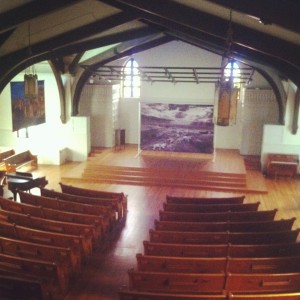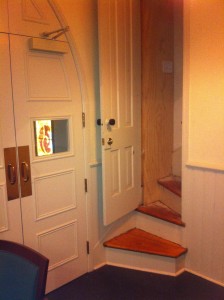When Tom Shadyac purchased the Haven’s building in 2007 for $2.15 million, the building was just like any other traditional, Southern church. Formerly known as the First Street Church, the historic church building was renovated and transformed into a new kind of community-gathering site for TJACH (Thomas Jefferson Area Coalition for the Homeless) and its clients. Like many downtown Charlottesville buildings, the old First Street Church building has lived through many political and social ages. The current building is recorded to have been built in 1920 (City Records), but one Haven guest I spoke with said his grandparents attended the church during early Reconstruction. The guest, Mr. B., spoke of his own childhood attending the church, where he recalled being frightened by the “spitting and yelling of brimstone and Hell,” but how the non-denominational church taught him to take religion seriously. That congregation relocated to a building in Keswick, a rural hamlet six miles from Charlottesville and known for its vineyard and idyllic farms.
As a double major in Religious Studies and Art History, I am constantly fascinated by how the architectural and visual shape of the space we inhabit informs how we feel and what we believe. Even following extensive renovation after TJACH’s acquisition, the space of the Haven resonates slightly out of tune between its original, liturgical context and its modern purpose. The Sanctuary is used by the Haven as a place of quiet contemplation and relief from the hubbub of the Day Haven. Community groups can also rent out the space for weddings, concerts, and events. It is a place where many voices join together in silence and in discussion. The interior space is exquisitely lovely, covered in stained glass windows and stately pews. The balcony in the back of the Sanctuary has an unspoken history; this is where the African American congregants sat during services.
The upper deck is accessible only by a very narrow staircase on the right hand of the foyer. Worshippers using the staircase to get to their seats would not have even entered the main space of the sanctuary or touched a pew. The relegation to this secondary space denied tactile access to the sanctified space. Congregants seated in the rear balcony have a great view of the rafters, but could not easily access the altar or choir. People sitting behind and above the congregation seated on the ground level would have been intentionally out of eyeshot. Today, the balcony is only used for roof access and to hang decorations. Events or gatherings held in the sanctuary have one seating option: all people together. In its contemporary use, the Haven’s sanctuary has been more than integrated; it has become a reconciled space. Once a mark of social hierarchy, the building now architecturally expresses the constant effort of restoring hope and the reconciliation of the invisible with the public. In its current state, the Haven’s public gathering space is just a more perfect expression of the wholeness innate in beloved community.

View from the balcony seating. The hung images are part of an ongoing photography festival in Charlottesville.
When the building was renovated in 2007, a four-story annex was added to house service-provider and Haven staff offices. This architectural update purposefully expounded upon the Haven’s collaborative atmosphere and made philosophy of community concrete in its bricks. The upstairs office room, where Haven staff call home base, is one open room surrounded with windows with vista views of Charlottesville proper. Each staff person has his or her own desk (until a certain summer intern needs to borrow a table) in this communal room. The openness facilitates pithy conversation, musical and intellectual musings, and presents the staff as a unified team to anyone who walks up the stairs looking for guidance. The redesigned spaces of the Haven’s building embody a healthy “confluence of optimisms,” a phrase Charles Marsh borrows from John Howard Yoder in his explanation of Martin Luther King Jr.’s formation of beloved community in the segregated American South (49).[i] MLK’s “confluence of optimisms” is the fortuitous meetings of the “kingdom of God…[and] the American dream,” and the aims of the Haven are not too different (49). All who visit and work with the Haven pursues the restoration of hope in self-sufficiency, wholeness and economic stability.
Unity is a happy byproduct, if not crucial element, of beloved community. By creating an open space, both physically and in philosophy, the Haven creates space for healing and resolution. By transforming the old First Street Church building into a community center, the Haven fosters an experiential and potent vitality Marsh describes in Clarence Jordan’s theology. An open workspace for staff and a purposefully integrated sanctuary space invites “experiences that are often more formative than participation in the sacraments” (59).
One of the main beneficial elements of maintaining an open and unified space is a suppression of latent violence. The Haven is a low-barrier shelter, meaning anyone in any (non-violent) state is able to walk in off the street in search of respite and support. Guests are not required to navigate a screening process or pass through metal detectors. Instead of imposing limits and strict guidelines to receive care, guests and staff voluntarily maintain an atmosphere of mutuality and trust. In a historic parallel, Marsh illustrates King’s developing sense of place for coercion in enacting political and social reform. Niebuhr, who argued, “coercion was a practical necessity in view of the collective selfishness of groups” became untenable with King’s later tendencies to change by example and nonviolent guidance (26). MLK felt the stirrings of nonviolent necessity when his parsonage was bombed in January of 1956. MLK calmed the tense crowd with a call to forgiveness and patience, urging his supporters not to resort to retaliation, but continue to extend hands of peace and friendship: King said, “The spirit of God was in our hearts, and the night that seemed destined to end in unleashed chaos came to a close in a majestic group demonstration of nonviolence” (38). As a low barrier shelter, the possibility for unleashed chaos is not absent from the Haven. However, the visiting crowds of guests and volunteers are committed to peace and coexistence. The thoughtfully-designed open spaces of the Day Haven, the unfettered access to staff, a beautiful sanctuary welcome to all, and a collaborative workspace produce a sense of architectural wholeness and a clear invitation for the formation of peaceful community.
“While the church as a worshipping community exists for the specific purpose of confessing, proclaiming and worshipping Jesus Christ as Lord, the beloved community quietly moves from its historical origins into new and unexpected shapes of communion and solidarity” (208). Marsh refers to the abstract church, but I believe this statement applies to one tangible church architecturally converted into a space for collaboration and radical unity on the corner of First and Market.
[i] Charles Marsh, The Beloved Community: How Faith Shapes Social Justice from the Civil Rights Movement to Today. New York: Basic Books, 2005.

